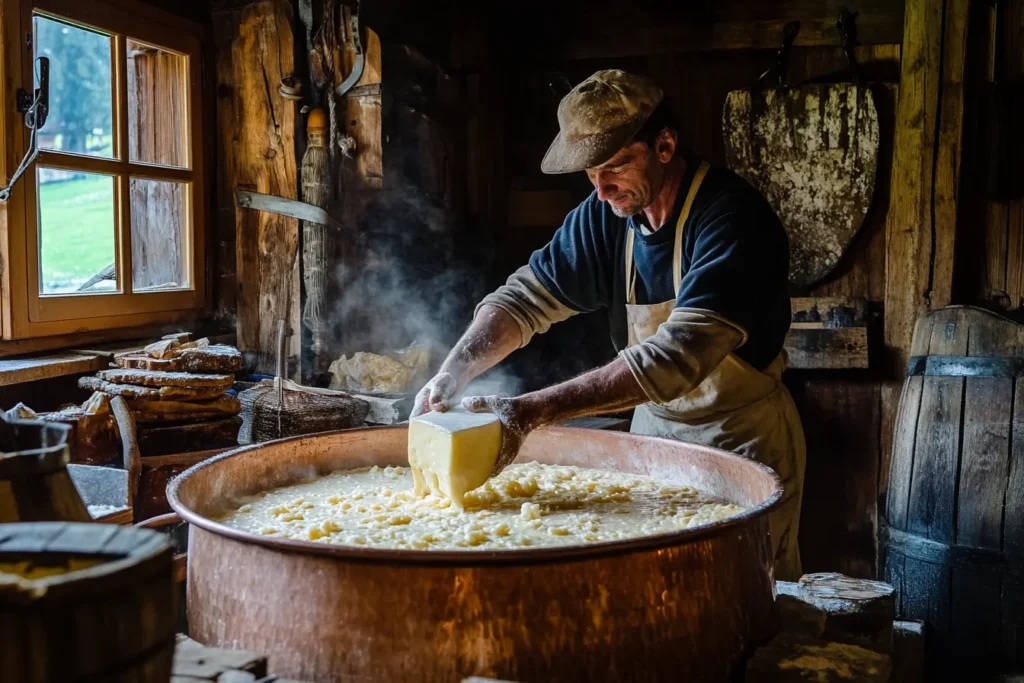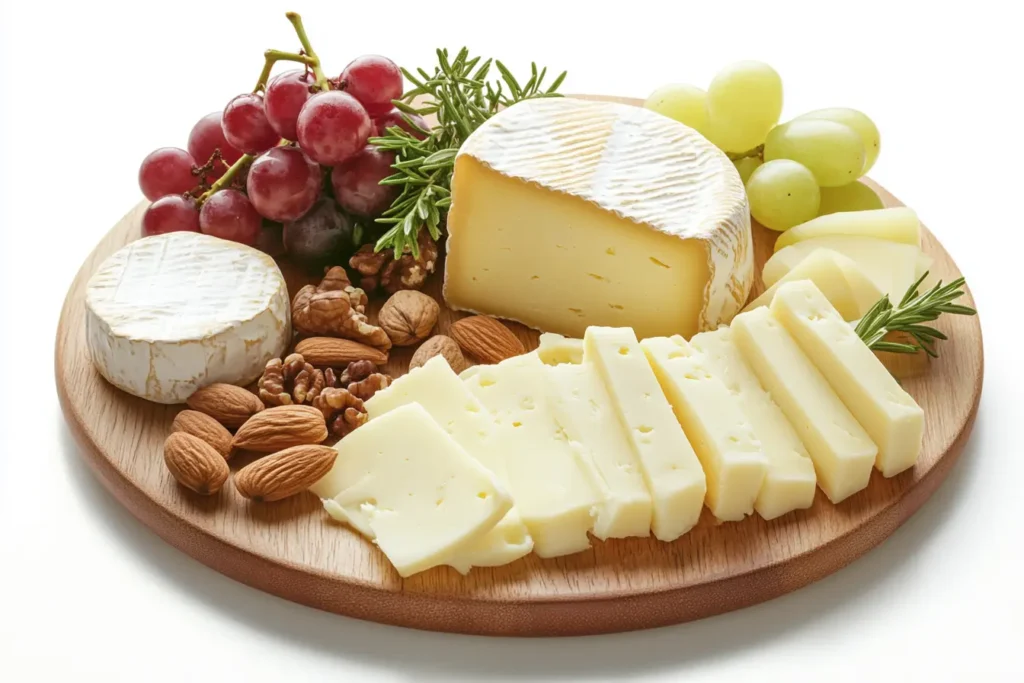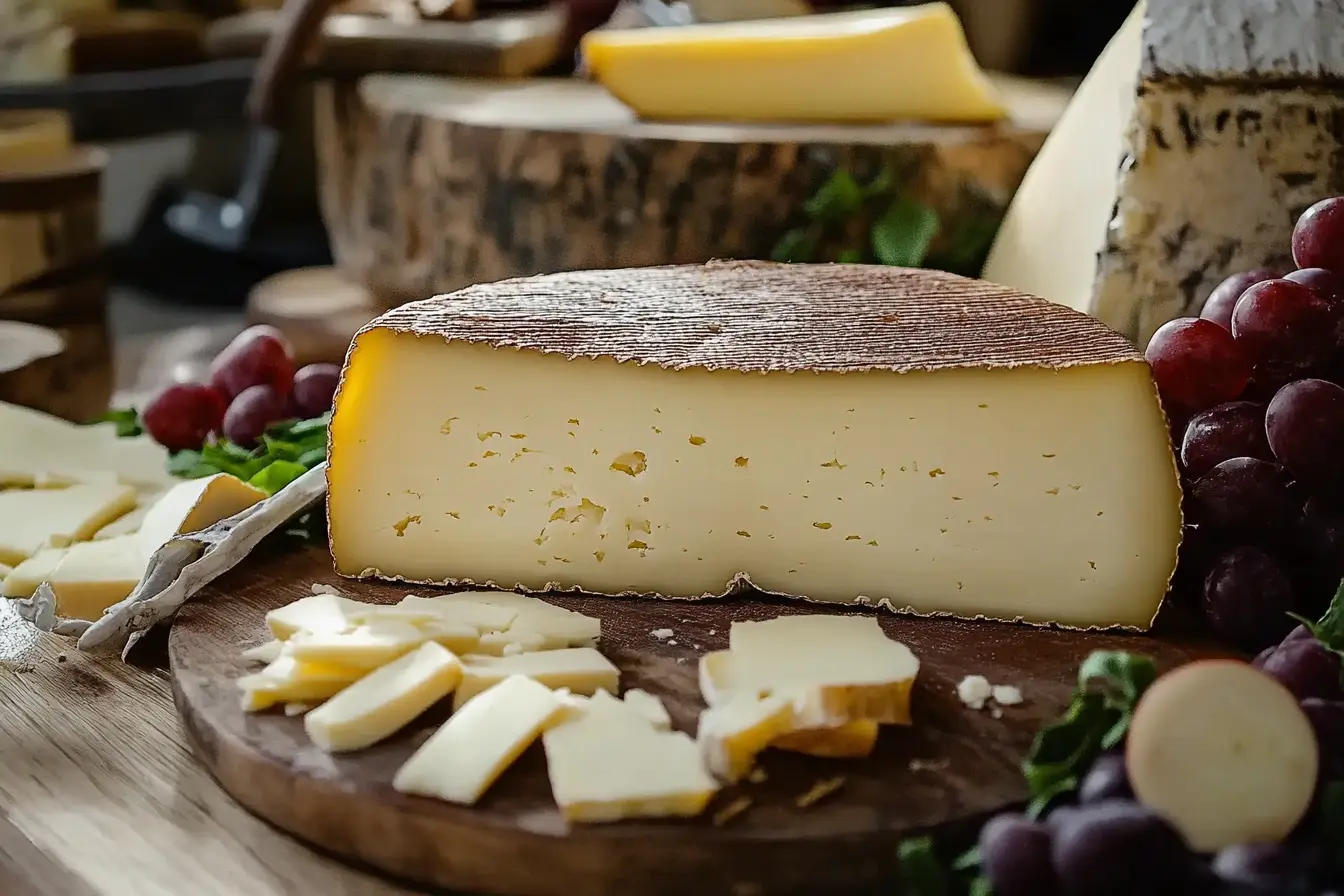Introduction
Gruyere cheese is a culinary treasure beloved for its versatile applications and distinct, nutty flavor. Originating from Switzerland, this cheese has secured its spot in kitchens worldwide, not only for its ability to melt beautifully but also for its historical significance and cultural value. Whether you’re a seasoned cheese enthusiast or a curious foodie, exploring Gruyere’s story, uses, and health benefits offers a rich and rewarding journey.
This article delves deeply into everything you need to know about Gruyere cheese. From its origin to its role in global cuisine and even how to store it properly, this guide has you covered. Let’s begin by laying the foundation: what exactly is Gruyere cheese, and why is it so popular?
What is Gruyere Cheese?
Gruyere cheese is a semi-hard cheese made from cow’s milk, known for its creamy texture and nutty flavor. It’s a staple in many European dishes and stands out due to its versatile nature—working equally well in recipes or as part of a cheese platter. But there’s more to this cheese than its taste.
Why Gruyere Cheese is Popular
Gruyere has been captivating taste buds for centuries. Its balanced flavor, which can be sweet, salty, and slightly earthy, appeals to both casual eaters and culinary experts alike. Not only does it bring depth to dishes, but its long shelf life and adaptability make it an essential addition to any kitchen.
What’s fascinating is that Gruyere cheese holds a Protected Designation of Origin (PDO) status. This guarantees that only cheese made in specific regions of Switzerland, following traditional methods, can be called “Gruyere.”
History and Origin of Gruyere Cheese
Gruyere cheese boasts a history as rich as its flavor, with roots firmly planted in the picturesque Swiss countryside. For centuries, Swiss communities have cherished this cheese as a cornerstone of their culinary traditions, crafting it with meticulous care and ensuring its enduring popularity.
Origins in Switzerland
The story of Gruyere cheese begins in the town of Gruyères, located in the canton of Fribourg, Switzerland. This region, celebrated for its lush pastures and pristine dairy farms, creates the ideal conditions for producing high-quality cheese. Historical records reveal that Swiss cheesemakers started crafting Gruyere as early as the 12th century, showcasing its long-standing appeal.
The region lends its name to the cheese, emphasizing its connection to the land and culture. Cheesemakers in areas like Vaud, Neuchâtel, and Jura continue to uphold these traditional practices, ensuring the preservation of Gruyere’s authentic qualities.
Protected Designation of Origin (PDO) Status
In 2001, authorities awarded Gruyere cheese the prestigious Protected Designation of Origin (PDO) status. This certification safeguards its authenticity and limits its production to specific regions of Switzerland. Only cheesemakers who follow the traditional methods in these regions can label their product as “Gruyere.”
The PDO label signifies more than a location. It represents quality, heritage, and a promise to consumers that their cheese adheres to strict standards. According to the PDO official site, this certification plays a vital role in preserving the integrity of regional specialties.
Characteristics of Gruyere Cheese
Gruyere cheese stands out among its counterparts for its distinctive qualities. From its creamy texture to its signature nutty flavor, this semi-hard cheese captures the essence of Swiss craftsmanship. Let’s dive into the details that make Gruyere a favorite worldwide.
Texture and Flavor Profile
Gruyere cheese offers a firm yet creamy texture that melts beautifully when heated, making it ideal for countless recipes. The flavor, which strikes a perfect balance between nutty and slightly sweet, evolves as the cheese ages.
When young, Gruyere possesses a mild and creamy taste, but as it matures, its flavor deepens, revealing earthy and complex undertones. This gradual change provides a variety of options for cheese enthusiasts who prefer different flavor intensities.
Appearance and Aging Process
Gruyere cheese features a pale yellow interior with a few small holes, known as “eyes.” These holes form naturally during fermentation, adding to its rustic charm. The outer rind is hard and golden-brown, which protects the cheese as it ages.
The aging process, or affinage, typically lasts anywhere from three to twelve months. Younger Gruyere delivers a softer and sweeter profile, while the aged versions—sometimes labeled as “Reserve”—offer a firmer texture and bolder flavor. Cheesemakers carefully monitor temperature and humidity during aging to achieve the perfect consistency and taste.
What sets Gruyere apart is its ability to adapt to culinary needs. It melts effortlessly for fondue or gratins but also holds its shape when sliced, making it a versatile addition to any dish.
How Gruyere Cheese is Made
The art of making Gruyere cheese reflects centuries of tradition and meticulous craftsmanship. Each step in the process contributes to the distinct flavor and texture that cheese lovers cherish. From selecting the finest milk to the intricate aging process, Gruyere’s production is a true labor of love.

Traditional Swiss Methods
Crafting Gruyere begins with fresh, high-quality cow’s milk sourced from cows grazing on the lush pastures of Switzerland. Farmers ensure that the milk is free from additives and preservatives, maintaining the cheese’s authentic flavor.
Cheesemakers heat the milk in large copper vats, adding rennet to coagulate it. Once the milk curdles, they cut the curd into small pieces to release whey, which they then separate. This step, known as “cheddaring,” gives Gruyere its dense, semi-hard texture.
The curds are placed into molds and pressed to remove excess whey, forming the cheese into its characteristic wheel shape. After pressing, the wheels are soaked in a brine solution to enhance flavor and extend shelf life.
Aging and Curing Process
Aging Gruyere cheese, also called affinage, is where the magic truly happens. The cheese rests on wooden boards in carefully controlled environments, where temperature and humidity levels are constantly monitored.
Cheesemakers flip and brush the wheels regularly to ensure even maturation and develop the signature golden-brown rind. The aging period typically ranges from three to twelve months, depending on the desired flavor profile.
Younger Gruyere features a smooth, creamy taste, while aged varieties—sometimes referred to as “Reserve”—offer a more robust, nutty, and slightly salty flavor. The extended aging process deepens the cheese’s complexity, creating layers of taste that delight the palate.
Commitment to Quality
Gruyere producers strictly adhere to PDO guidelines to protect its authenticity and uphold traditional practices. This commitment ensures that every wheel of Gruyere cheese embodies the heritage and quality Swiss cheesemakers have honed over centuries. You can learn more about these standards at Cheeses from Switzerland.
Culinary Uses of Gruyere Cheese
Gruyere cheese shines in the culinary world due to its versatility, creamy texture, and rich flavor. From elevating classic recipes to starring in everyday meals, this cheese brings a gourmet touch to various dishes. Whether melted, shredded, or sliced, Gruyere effortlessly adapts to countless cooking styles.

In Iconic Dishes
Gruyere plays a starring role in some of the most beloved dishes in European cuisine. Its melt-in-your-mouth quality and nutty undertones make it indispensable in recipes like:
- Cheese Fondue: Gruyere combines perfectly with other cheeses to create a creamy, flavorful fondue that’s perfect for dipping bread or vegetables.
- Croque Monsieur: This classic French sandwich owes its rich, gooey texture to melted Gruyere layered with ham and béchamel sauce.
- Quiche Lorraine: Gruyere is a key ingredient in this savory tart, adding depth to its custard-like filling.
Everyday Uses
Beyond its role in gourmet dishes, Gruyere shines in everyday cooking. Its ability to melt seamlessly makes it a go-to cheese for:
- Gratins: Whether in potatoes or vegetables, Gruyere enhances gratins with its creamy texture and golden-brown crust.
- Soups: A generous sprinkle of Gruyere over French onion soup creates a delightful layer of melted goodness.
- Sandwiches: Gruyere turns an ordinary grilled cheese or panini into a decadent treat.
As Part of a Cheese Board
Gruyere adds sophistication to cheese boards, pairing beautifully with fresh fruits, nuts, and artisan bread. Its unique flavor profile complements a variety of accompaniments, making it a crowd-pleaser at gatherings.

Enhancing Everyday Dishes
Shredded Gruyere adds richness to pasta dishes, while thin slices elevate simple omelets. You can even use it to top baked goods or stuff chicken breasts for a flavorful surprise.
Gruyere’s versatility and ability to elevate both simple and complex dishes make it a staple in kitchens worldwide.
Pairing Gruyere Cheese with Foods
Gruyere cheese is not only delicious on its own but also shines when paired with complementary foods. Its nutty and slightly sweet flavor profile makes it versatile enough to elevate a range of dishes and snacks. Let’s explore the best pairings to bring out the full potential of Gruyere.
Perfect Food Pairings
Gruyere’s unique taste blends harmoniously with a variety of foods, creating unforgettable combinations. Here are some ideal pairings:
- Fresh Fruits: Grapes, apples, and pears enhance Gruyere’s sweetness while balancing its savory notes.
- Nuts: Almonds, walnuts, and hazelnuts provide a crunchy contrast to the cheese’s creamy texture.
- Artisan Bread: Rustic baguettes, sourdough, or rye bread complement Gruyere’s rich and nutty flavors.
- Vegetables: Roasted or steamed vegetables, like asparagus and broccoli, pair wonderfully with melted Gruyere.
Gruyere as a Complement to Meat and Seafood
Gruyere’s robust flavor enhances poultry, beef, and even seafood dishes. For example, you can melt it over roasted chicken or use it to create a creamy sauce for grilled fish.
Cheese Boards and Charcuterie
When added to a cheese board, Gruyere becomes a standout item. Pair it with mild cheeses like brie or stronger options like blue cheese for a balanced spread. Include thinly sliced cured meats, such as prosciutto or salami, for a harmonious combination.
Tips for Pairing Success
To achieve the best results, aim for balance in flavors. Gruyere’s slightly salty and nutty profile complements foods with sweetness or acidity. For added texture, choose crunchy accompaniments like nuts and crisp crackers.
FAQs
Gruyere cheese contains very low levels of lactose, especially in aged varieties. During the aging process, most of the lactose breaks down, making it a suitable choice for those with mild lactose intolerance. However, it’s always best to consult a health professional if you’re unsure.
If Gruyere isn’t available, you can use substitutes like Emmental, Comté, or Jarlsberg. These cheeses share a similar texture and flavor profile, although they may lack Gruyere’s distinct nutty undertones.
While both Gruyere and Emmental are Swiss cheeses, they differ in flavor and texture. Gruyere is creamier and nuttier, with smaller holes, while Emmental is milder with larger holes and a slightly sweeter taste.
Yes, the rind of Gruyere cheese is edible. However, some people find it too hard or strong in flavor. It’s perfectly safe to eat but often removed for recipes or cheese boards.
Once opened, Gruyere cheese should be stored in the refrigerator, wrapped tightly to prevent drying out. It typically lasts 2-3 weeks if stored properly. For best results, use parchment paper instead of plastic wrap to allow the cheese to breathe.
Gruyere is incredibly versatile! You can use it in fondue, quiches, soups, gratins, or simply melt it over vegetables or sandwiches. Its creamy and nutty flavor enhances both simple and elaborate dishes.

